Some people like to avoid the first model year of a new design. Others want the new new thing while it's still new. Car enthusiasts are especially likely to fall into the latter camp. And those who prefer their cars compact and relatively affordable have two new new things to pick from for 2015, both icons, the Volkswagen GTI and the Subaru WRX. I've now been able to spend a week in each. How does the Subaru stack up?
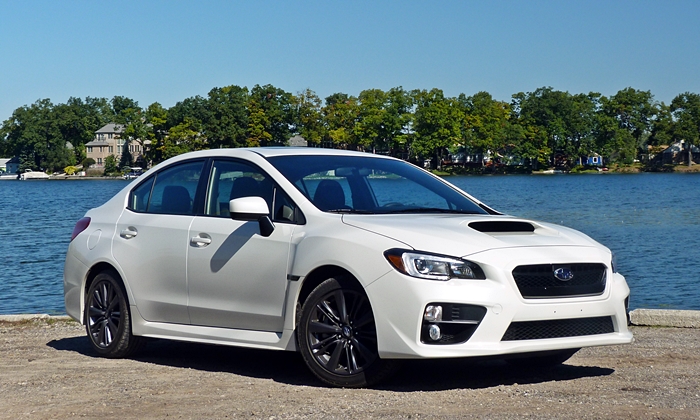
Under the flared fenders and body kit lives the body of an Impreza. more WRX photos
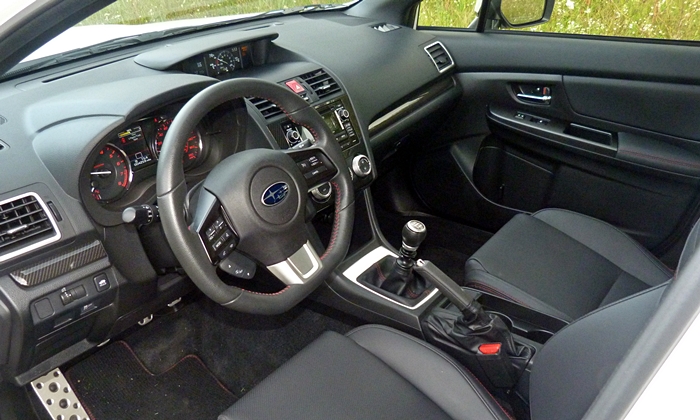
WRX interior offered in any color you want as long as it's black. With red stitching.
| |
Compared to the Golf / GTI |
| Handling |
 Better
Worse
Better
Worse
|
I last drove a Subaru WRX a couple years ago because I needed a comparison car for a Mitsubishi Evo. (Not a fair comparison, but I couldn't get my hands on the more comparable WRX STI.) That WRX felt cushy and sloppy compared to the Evo. Was this the icon we'd lusted after a decade earlier, before attention shifted to more powerful, bigger-buck machinery like the Nissan GT-R?
With the 2015 redesign, Subaru has dramatically tightened up the suspension of the regular WRX. It's still not as rock hard or as lightning quick to respond as an Evo, but nearly all of the slop has departed. There's still some lean in turns, but excellent control over body motions. The new body structure feels more solid than that of most Asian cars--quite a change from earlier WRXs--and not too far off the VW's. This improves both handling precision as well as impressions of the car's quality. Brake-based torque vectoring limits understeer, so the new WRX also feels much more balanced than the old one.
The new electrically-assisted steering feels linear and precise, and loads up nicely as the wheel is turned. Unless you're really hitting a corner hard; then it can go mum when feedback is most needed. Luckily, more information on how well the tires are gripping (usually quite well) arrives through the seat. The GTI's steering has a similar feel in typical public road driving in its sport setting, but improves rather than goes AWOL under duress. The Focus ST, which has much tighter, quicker steering, can be more entertaining than either. But many reviewers have found the Ford's tuning overly aggressive.
I've also briefly driven the WRX STI on a track. The STI retains hydraulic steering with a quicker ratio, and this system communicates a bit more. But the way the STI's limited-slip front differential twitches the steering wheel in turns at speed unsettled me.
The regular WRX lacks the STI's limited-slip front and rear differentials and adjustable center differential. But in the most aggressive driving arguably appropriate for public roads I didn't miss this hardware. All-wheel-drive abetted by brake-based traction control make it possible to power out of turns far harder than is possible with front-wheel-drive cars like the GTI and Focus ST. Power the WRX into oversteer, and its stability control system cuts in appropriately and unobtrusively.
All in all, while I'm most entertained by the more aggressively tuned, friskier Ford Focus ST, I found the GTI uncannily easy to finesse through curves. Its electronically enhanced chassis virtually autotuned my driving skills. The new WRX doesn't handle quite well as the GTI, but it's not far off, and it has a trump card to even the score: the additional traction of permanently engaged all-wheel-drive.
| Driving position & visibility |
 Better
Worse
Better
Worse
|
Subarus continue to be designed by engineers. Or to be designed by designers who live under the thumbs of engineers. One result: even in the all-new WRX you sit high above the instrument panel in comfortable, supportive seats and view the outside world through large windows. Together with the new suspension tuning (if not always the steering), this inspires confidence.
This said, the new car is so much roomier that it felt a little larger around the elbows than I'd personally prefer. A tighter car would feel sportier. But if you want or need space, you'll find it here. Especially if you get the base trim, without the sunroof.
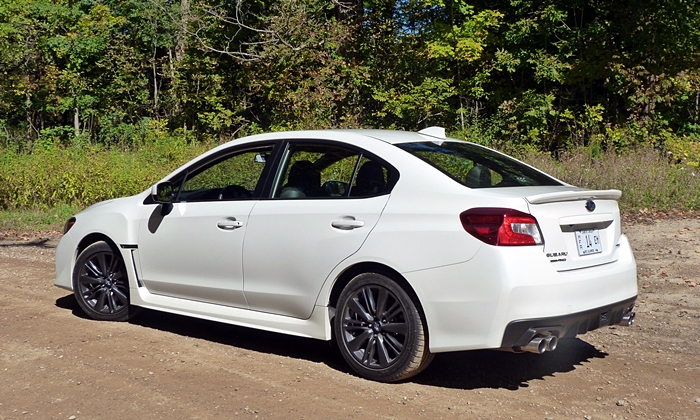
Subaru originally created the WRX to compete in World Rally Cross (hence its name).
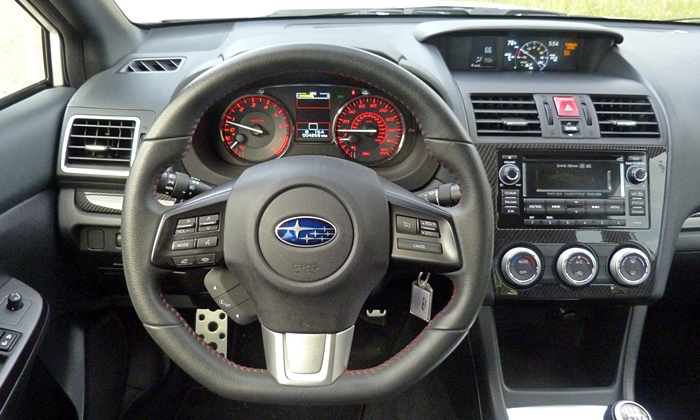
Screen at top of center stack toggles among boost gauge, traction display, trip computer, etc.
| Powertrain performance |
 Better
Worse
Better
Worse
|
With many of the latest turbocharged engines, including those in the Volkswagen GTI and the Ford Focus ST, you'll only notice the boost kick in if you're paying close attention. The WRX has a new direct-injected engine for 2015, a 268-horsepower 2.0-liter instead of the previous 265-horsepower 2.5-liter, but it retains old-school turbo flavor. There's a distinct transition as the boost kicks in. You feel it, and hear it.
But the new engine's on/off character makes for more of a rush than the GTI's when you do want to get on it. Once the turbo spools up (in a blink of an eye over 3,000 rpm) the engine, with a distinctively grumbly flat four sound, pulls hard. This is a very quick car. The new STI, which retains the old STI's 305-horsepower 2.5-liter engine, isn't any quicker. All-wheel-drive makes it much easier to employ the full power of the engine than in the front-wheel-drive competitors. Especially if the road isn't straight. Or dry.
All is not well with the powertrain, though. The six-speed manual transmission sounds and feels clunky. You'll find much better shifters in the Focus ST and GTI--and those are hardly the best. Also, the engine's bipolarity isn't optimal for around-town drivability. If you're not making a conscious effort to either keep the engine below or above the point where the turbo fully spools up, boost will kick in just as you shift. It's much easier to drive the Focus ST or especially the GTI smoothly.
A continuously variable transmission (CVT) that can be manually shifted among eight simulated gears is optional. I briefly drove a new WRX with the CVT, and didn't care for it. Though Subaru's CVT is about as good as they get, even when using the fixed ratios the engine felt weaker and far less responsive than with the manual. As much as I mind the clunkiness of the manual, I strongly prefer it to the CVT. Comparing two-pedal cars, the GTI with its optional DSG automated dual clutch manual transmission delivers a much more satisfying and engaging driving experience.
| Rear seat room & comfort |
 Better
Worse
Better
Worse
|
The Subaru WRX has always been fun to drive. But it used to be cramped inside, especially in the back seat. This is no longer an issue. The new car has more rear seat legroom than the one-size-up Legacy had during its 2005-2009 glory days. Unless your friends and family are tall, they'll fit in back. While the GTI's back seat is nearly as roomy, the Focus ST's isn't in the same ballpark.
If you want rear air vents for your passengers, though, you'll have to get the VW or the Ford. Subaru doesn't offer them in the WRX.
| |
Compared to the Golf / GTI |
| Exterior styling |
 Better
Worse
Better
Worse
|
Subaru, as if seeking to maximize disappointment, tends to transform stunning concept cars into forgettable (or worse) production cars. Sadly, the latest WRX is no exception. They promised styling completely different from that of the Impreza--these would be two separate cars going forward. They displayed a stunning concept at the 2013 New York auto show. The 2015 production car is an Impreza with flared fenders. While I wouldn't call the car ugly, my eyes aren't tempted to linger, either. Especially not with white. Subaru's signature "world rally blue" better suits the car.
| Interior styling |
 Better
Worse
Better
Worse
|
Subaru has dramatically upgraded the WRX's interior materials. Some of them anyway. The door pulls and center console remain econo-styled hard plastic, but the instrument panel and most of the upper doors are now soft to the touch. The door-mounted armrests are now downright cushy. Moving deeper, the body feels solid and the doors close with a reassuring thunk. The Focus ST might still be nicer inside, and the new GTI nicest of all, but the WRX's interior materials and structural solidity are now competitive.
Unfortunately, Subaru hasn't done anything dramatic with the interior styling. If anything, aside from the WRX Limited's red-stitched black leather steering wheel and seats (which do look good), the new car's interior is un-styled. Okay if you're all about function over form. But if you wanted a car that seems artful or at least special inside, this isn't it.
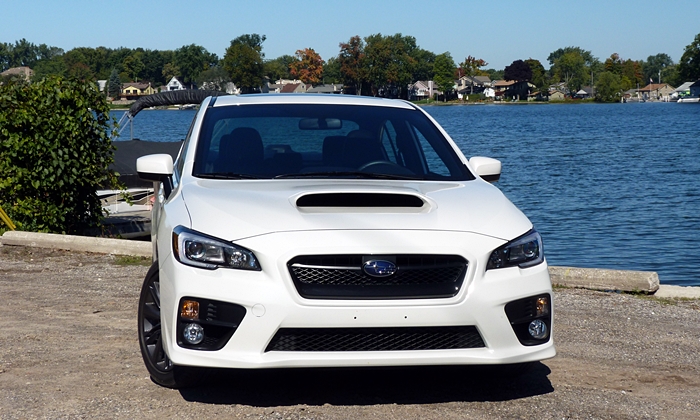
Limited trim has LED low beams. Large hood scoop feeds air to intercooler.
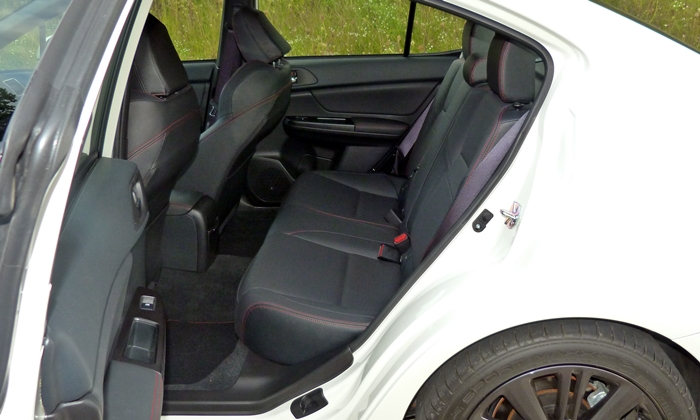
Back seat now roomy enough for adults.
| Cargo capacity |
 Better
Worse
Better
Worse
|
The new Subaru WRX's trunk can hold twelve cubic feet, about average for a compact. But it's a trunk. The GTI and Focus ST are both more versatile hatchbacks. Subaru used to offer the WRX in both wagon or hatchback AND sedan forms. But they're only offering the new one as a sedan, at least so far. (The Impreza on which the car continues to be based, earlier PR to the contrary, is also available as a hatchback.)
| Ride smoothness |
 Better
Worse
Better
Worse
|
The WRX's new spring and damper tuning strikes a good balance between ride and handling for enthusiasts who'll be driving the car daily on less than perfect streets. It's far more livable than an Evo's and about even with the Focus ST's. But non-enthusiasts (and even enthusiasts who just want to get home after a long day at work) will find the tuning on the firm side. Bumps can register with a loud thunk, and on some roads the WRX's ride can feel a little busy. Other reviewers report a clear edge for the GTI in this category. (I've yet to drive the Volkswagen on badly paved roads.)
| |
Compared to the Golf / GTI |
| Fuel economy |
 Better
Worse
Better
Worse
|
Fuel economy isn't quite a strength, but it's no longer a weakness, either. The new Subaru WRX with its new smaller (but not weaker) engine scores better in the EPA's tests than the old one. City mpg is up from 19 to 21, while highway mpg is up from 25 to 28. In my real-world driving, the trip computer reported averages between 22 and 25 mpg when I enjoyed the car's power, and a little over 30 when I made minimal use of the turbo.
Despite the supposed efficiencies of its type, the CVT dings fuel economy. Its EPA ratings are the same as last year's manual transmission WRX.
The real problem with the WRX's fuel economy, though, is that the new GTI rates much higher: 25 mpg city, 34 mpg highway. The Focus ST splits the difference with 23/32. Even cutting the WRX a couple mpg of slack for all-wheel-drive, it doesn't quite match the others.
| Quietness |
 Better
Worse
Better
Worse
|
The new Subaru WRX is quieter than earlier ones. Wind noise is fairly low, road noise is moderate, and the exhaust drones only at low rpm, so even long distances on the highway shouldn't prove tiring. The GTI and Focus are both quieter inside, though.
| Price or payments |
 Better
Worse
Better
Worse
|
As high-performance all-wheel-drive cars go, the Subaru WRX is inexpensive. But that doesn't mean it's inexpensive, with a $27,090 starting price. Add $2,200 for the Premium trim level, which includes a sunroof, heated seats, fog lights, illumination for the visor mirrors, and a demure rear spoiler. Add another $1,500 for the Limited trim (as tested, $30,790 total), which includes leather upholstery, a power driver seat, and automatic headlights with LED low beams. The CVT can be added to the Premium or Limited for $1,200. Navigation with a Harmon/Kardon audio system lists for $2,000 on the Premium. The same plus a proximity key lists for $2,500 on the Limited. So if you don't want to take the key out of your pocket, you've got to go all-in, to the tune of $33,290.
A mid-level 2015 Volkswagen GTI lists for $1,975 less. The GTI doesn't have all-wheel-drive, but does have a number of features not offered on the Subaru. In terms of typical values, these nearly cancel out. So you're paying more for the more powerful but less upscale car.
Some people will buy a Subaru WRX instead of a Volkswagen GTI because of the brands' disparate reliability reputations. But VW reliability has been improving, while Subaru's record is not spotless. Specifically, new Subaru engine designs often have first-year faults (some 2008 WRXs suffered crankshaft bearing failures, 2011 Forester engines are prone to valve cover leaks), and it remains to be seen whether head gasket leaks are entirely a thing of the past. Both cars are new this year, and it remains to be seen how they'll hold up.
This said, the current Impreza, on which the WRX is based, was introduced three years ago and has been highly reliable so far.
The new Subaru WRX is the most thrilling yet, with fewer downsides than in the past.
If you want an all-wheel-drive performance car with a price in the mid-20s to low-30s, this is it. The WRX remains ultra-quick while handling much better than the 2009-2014 rendition. And it'll go farther on a gallon of gas. The on/off engine isn't the easiest to drive smoothly around town, but enhances the rush when you're seeking (and likely finding) some thrills. Likewise the car's ride. Though a touch thumpy when you're trying to relax, the suspension tuning feels spot-on in spirited street driving.
With past WRXs, iffy styling and interior materials were also part of the deal. This isn't as much the case with the new WRX. Build quality and refinement, while not up to 2015 GTI levels, have substantially improved. For enthusiasts seeking plenty of power AND traction, and who don't feel the need for sexy styling, the trade-offs will seem justified. For those less willing to make such trade-offs, there's the GTI.
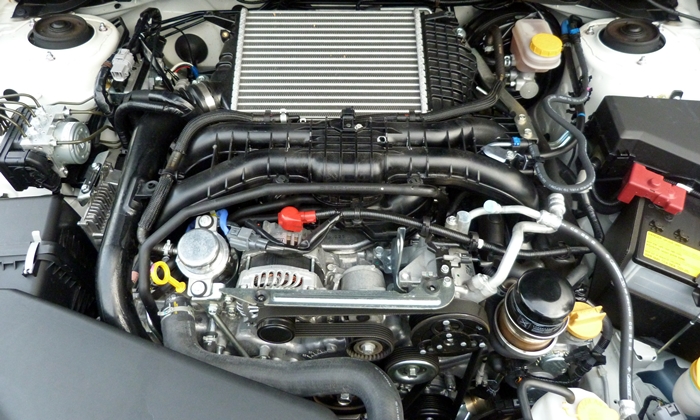
New engine smaller, but just as powerful and more efficient. Credit direct injection.
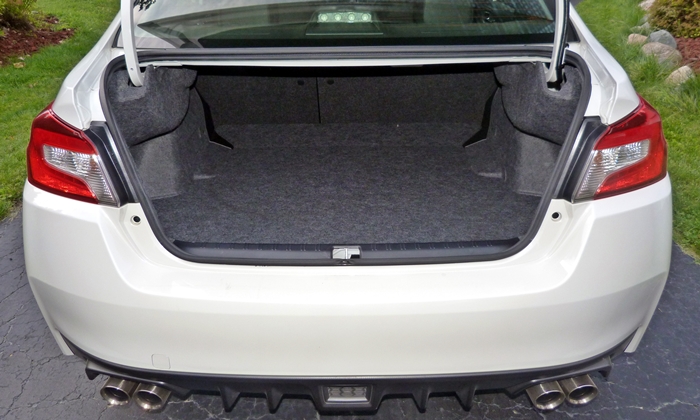
Decent trunk, about average for a compact sedan. I\\\'d personally prefer a hatch.
See more 2015 Subaru WRX photos
Subaru provided an insured car for a week with a tank of gas. Volkswagen provided airfare, hotel, meals, and insured, fueled cars at an event for invited media.











